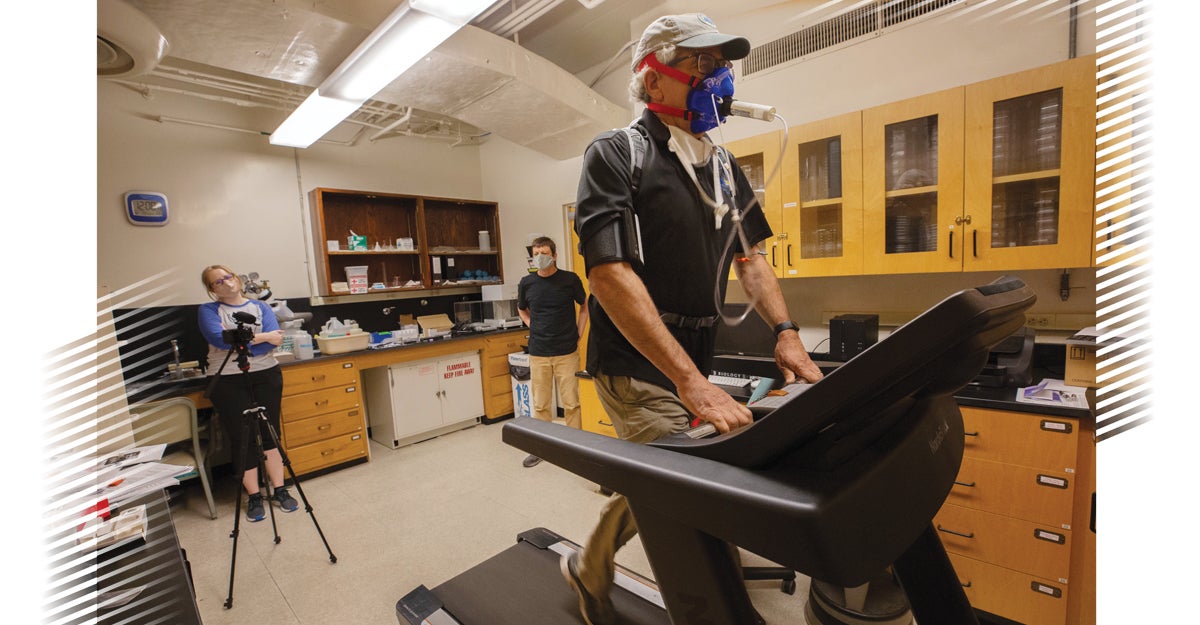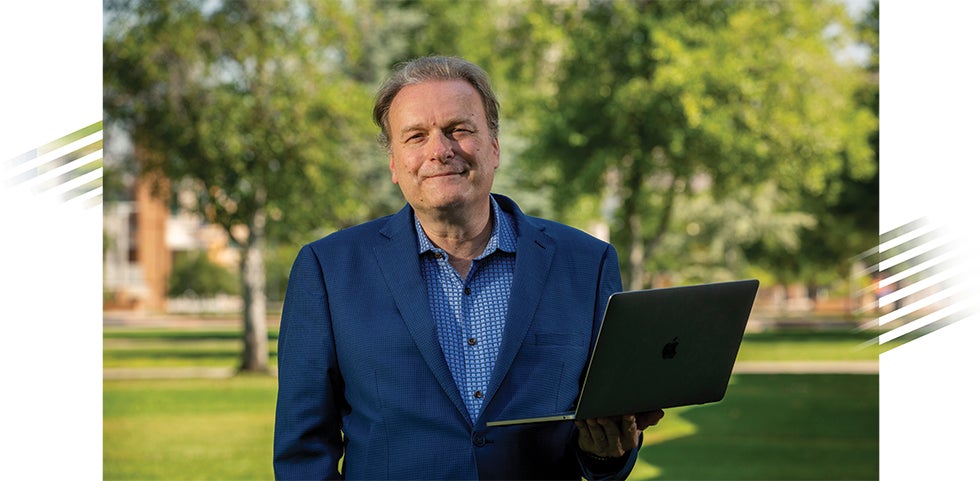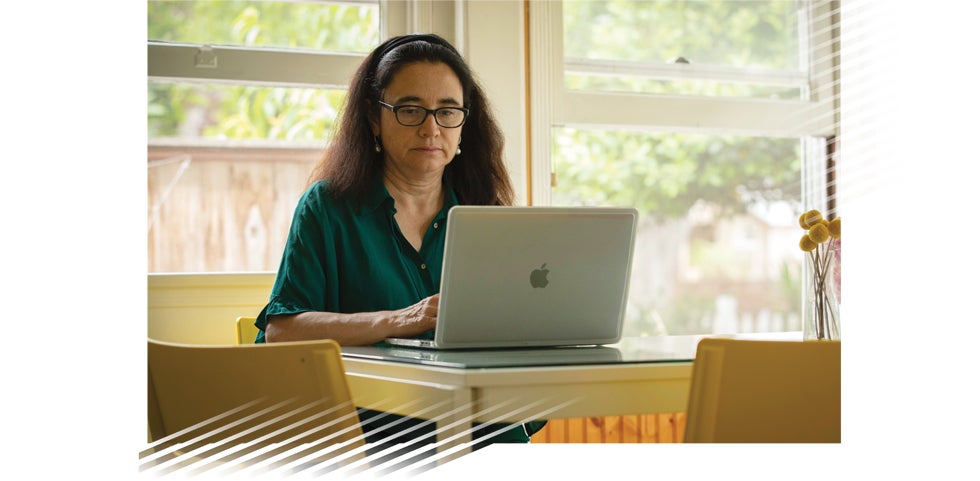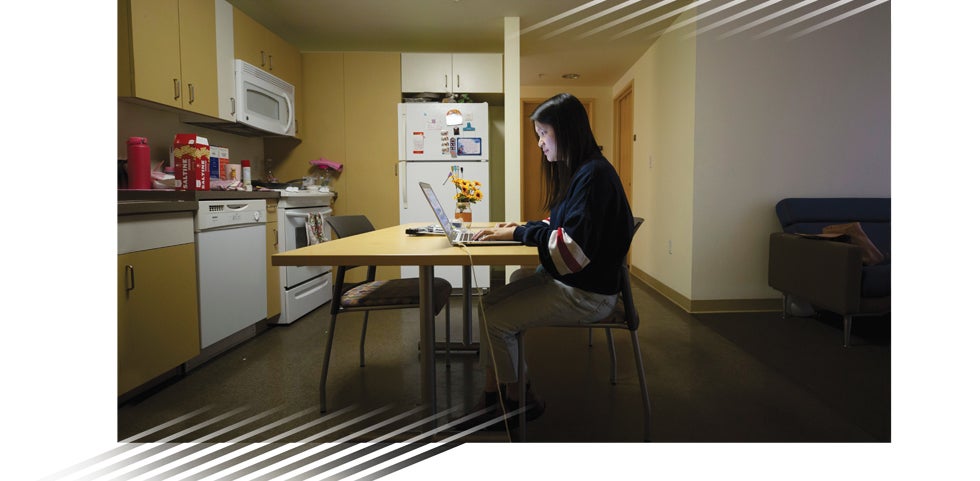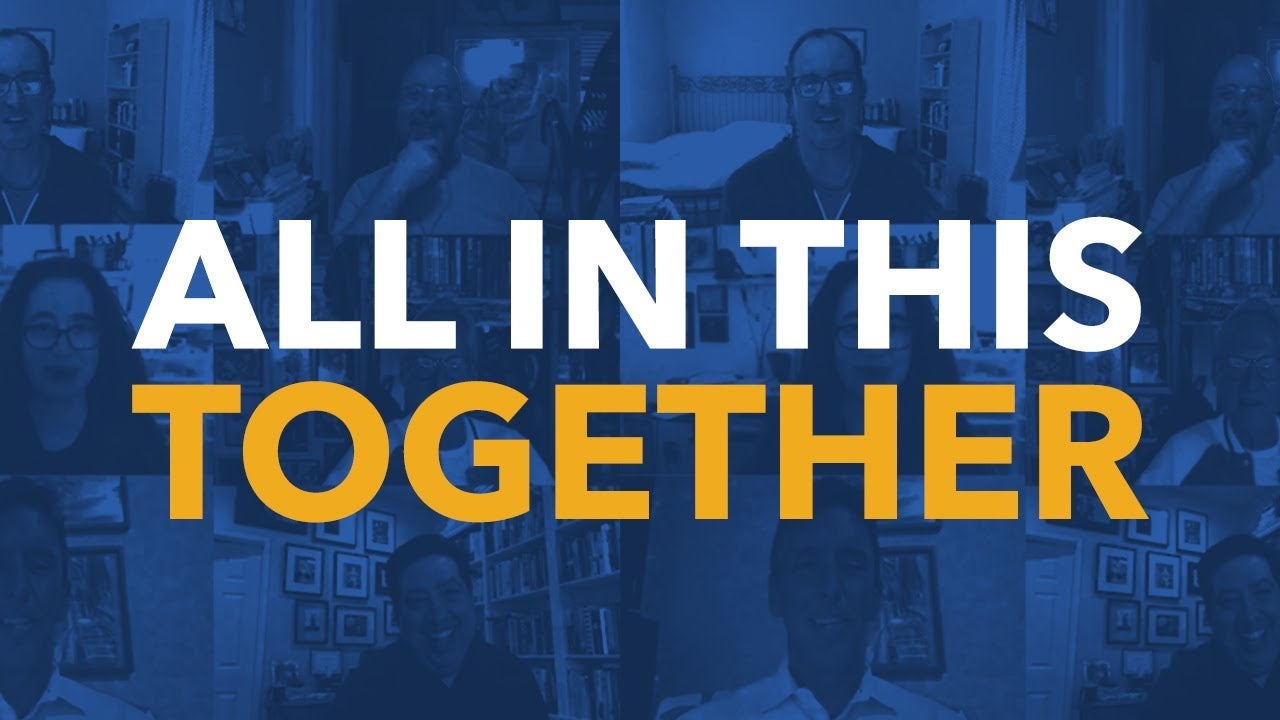Professor Rich Cardullo, right, performed experiments on himself in order to teach his human physiology course remotely.
TOGETHER APART
Staff, faculty, and students share their experiences adapting to remote teaching and learning.
By Jessica Weber
Photos by Stan Lim
he rapid closure of campus on March 13 came directly before finals week of winter quarter, meaning exams for roughly 3,000 courses had to be moved online and spring classes drastically modified to be taught remotely. The Exploration Center for Innovative Teaching & Engagement, or XCITE — a unit within the Undergraduate Education office formed in November to assist faculty with course development and technology integration — quickly became a vital player in UCR’s sudden transition to remote learning, spearheading the development of online platforms and supplying training and resources for instructors. XCITE personnel were also charged with providing technological support and assisting instructors with redesigning courses, among other services, in coordination with teams from UCR Library’s Teaching and Learning Services.
“We would typically have months, if not years to prepare for such a transition, and we were trying to do it in a couple of weeks,” said Richard Edwards, director of XCITE. Edwards also co-leads the continuity of teaching task force, a collaboration between XCITE; Information Technology Solutions, or ITS; and UCR Library, which formed in response to the shutdown.
“We convened multiple task forces very quickly, and there is a lot of cooperation across campus,” he said. “It really takes a lot of people coming together very quickly to make any of this possible.”
Richard Edwards, director of XCITE, was instrumental in facilitating UCR’s shift to remote learning.
A learning curve
This was the first experience with remote teaching for most UCR faculty members, and it proved daunting for many. Patricia Cardoso, a professor in the Department of Theatre, Film, and Digital Production, at first thought it would be impossible to teach her filmmaking classes online.
“I reached out to professors at UCLA and USC and asked what they were doing,” said Cardoso, who directed the 2002 film “Real Women Have Curves.” “We give each other ideas and discuss the work students are doing.”
Jonathan Ritter, an associate professor of music, had to figure out how to convert his 300-student world music course — a class that normally sees students venturing out into the community to experience new genres of music from different cultures — to one that could be completed at home using online resources and recorded performances. As a class that relied heavily on students hearing music, this proved to be especially time consuming.
“It took six to eight hours to convert an existing test to online to allow for audio and accommodations for students,” he said. “The workload for some of these things — things you’re already done with — is work you suddenly have to do again.”
Rich Cardullo, a biology professor at UCR for nearly 30 years, acknowledged moving his two courses online required a huge learning curve. To facilitate his lab course on human physiology, he had to learn how to produce and edit video demonstrations and create a YouTube channel for experiments normally done in person.
“This is all stuff I’ve just learned over the last 10 weeks,” he said. “I have always been proud of the fact I don’t use social media very often, but this is a new reality, and we’ve all had to learn this in very short order.”
Brigham Willis, senior associate dean of medical education for the School of Medicine, not only had to convert his own courses to accommodate remote learning, but also assist with the conversion of the entire school’s curriculum.
“We had to do a lot of faculty development and purchased a number of online platforms for adjunctive learning through external vendors,” he said, noting the school acquired software allowing students to treat virtual patients. “It’s not the same as a real patient, but it at least gives some experience in lieu of being live with patients.”
Faculty and students were presented with unique challenges both in maintaining an effective learning environment and managing the range of obstacles caused by the pandemic itself.
“It’s been kind of a rollercoaster,” Cardoso said. “After some classes I felt … the students are learning so much, and then other times … the students are not learning anything, and they are bored. I’ve had to learn to manage my emotions.”
Willis noted students will need real-life experiences in clinics and hospitals to complete their training.
“It’s pretty much impossible to replicate,” he said.
Early on, Cardullo thought getting up to speed would be the hardest challenge, but he discovered keeping students engaged when they start becoming “Zoom weary” has been the most difficult task. Not being able to interact with his students in person has also been a big adjustment.
“I tell my students, ‘I know you all are graduating, but I hope someday we get to meet,’” he said. “There really is no substitute.”
Marina Joseph, a third-year biology student in both of Cardullo’s classes, has found it difficult to stay connected to other students through a screen. She’s also had trouble finding a quiet place to study and take exams.
“If Orbach and Rivera (libraries) were people, I would tell them I really miss them, and that I’ll never take them for granted again,” Joseph said.
While Ritter has dealt with a number of technological hiccups that come with teaching a music course online, his toughest task is trying to accommodate and support students with immense personal challenges due to the pandemic.
“Students are in such radically different personal living and learning situations right now,” he said. “I have students sitting around bored wishing they were back in school, but I also have three students who have COVID-19 right now — two of them are sisters who lost their father. Trying to balance keeping students engaged and not leaving in the dust students who are facing unimaginable circumstances has been a real challenge.”
Survival of the Fittest
Faculty members have managed to come up with a number of creative solutions to keep their courses going. For her two courses on directing and producing a web series, Cardoso had her students produce videos using Zoom. Instead of working together on set, students directed fellow classmates through Zoom, recruited family members and roommates to serve as actors and production crew, and in some cases, assumed all the roles themselves.
“I always tell them, what Darwin discovered, it wasn’t the one who was strongest, but the fittest was the one who adapted faster,” she said. “I'm always teaching that, so this has been a great opportunity for the students to learn that skill.”
For Cardullo’s human physiology lab, he worked with his three teaching assistants, an academic coordinator, and XCITE to produce video demonstrations and record experiments that would normally be conducted by students. He and his TA’s recorded themselves doing things like administering electrocardiograms and drawing blood for glucose tolerance tests.
Professor Patricia Cardoso adjusted her filmmaking classes to teach students how to make web series using Zoom.
“I told them, ‘Let’s be honest, you’ve always wanted to see the professor get hurt — well this time, you’re going to see the professor bleed for you, so it’s not all bad,’” Cardullo said. “We try to keep it light. They’re stressed enough.”
In addition to virtual patient software, the School of Medicine faculty used telehealth extensively, allowing students to join physicians on telemedicine calls with actual patients, Willis said. They have also focused on teaching concepts through online interactive learning modules, seminars, and small group sessions to teach clinical skills such as patient interviewing and physical diagnosis. The anatomy instructional team even put together a program to replace in-person dissection using 3D virtual anatomy tools and videos in a matter of days.
“It was really inspiring to see the whole faculty come together and come up with a viable online alternative for these things that are really hard to do,” he said.
Ritter said the music department had to invent ways for students to play together remotely. Some instructors have started prerecording sections of music that students can use to practice.
“Students get almost like a karaoke track,” he said.
Brittenny De La Cruz, a senior neuroscience major in Ritter’s music course, said she’s surprised at how much she enjoyed taking the class from home.
“It’s been a pretty wonderful experience to be honest,” she said. “I really enjoy the time (Ritter) takes in providing us with examples of music going on in the world with regards to the coronavirus. It’s nice that he isn’t trying to avoid the topic or ignore the circumstances we are facing.”
Gearing Up
Following the shutdown, more than 1,000 instructors began moving their courses to the learning management system iLearn, so UCR’s 25,000 students could continue their education. ITS staff expanded the capabilities of iLearn to accommodate the surge in traffic. Additionally, about 4,500 Zoom Pro licenses were issued to better facilitate remote courses and interactions between faculty, students, and staff. UCR also implemented the Loan2Learn program, which offered more than 360 laptops to students without access to devices that could support remote learning. Nearly 170 mobile hotspots were made available to students without access to Wi-Fi, and the websites Keep Teaching and Keep Learning were developed as informational hubs for students and faculty, respectively.
Silver linings
At the onset of the shutdown, Edwards was optimistic that faculty members and students would find remote learning beneficial. He noted there are advantages to conducting classes remotely, such as the ability for students to learn at their own pace, re-watch lectures, and access materials easily online.
“A properly set up remote teaching course can have more peer-to-peer interaction than even a face-to-face course,” Edwards said.
Despite missing the in-person interactions, both Cardoso and Cardullo noted they have found a lot of utility in using Zoom, particularly being able to separate students into groups using breakout rooms. They said students are more willing to engage and participate in these smaller groups virtually than they normally would in their large in-person classes. Going forward, Cardullo plans to build in some time for students to work together remotely.
“I am also seeing more students and getting to know them better,” Cardullo said. “There’s something about displaying students in sort of this ‘Brady Bunch’ format. I’m getting to know the students’ personalities I would say better than otherwise I would.”
Cardullo has also been holding virtual one-on-one check-ins with students. He said these have been more effective than normal in-person office hours because the number of students dropping by has dwindled over the years.
“That makes me sad,” he said. “I’m a people person, and I like to get to know students. This is my way of coming to them.”
Ritter has also found conducting class through Zoom useful in making sure students are understanding the material. He said he has kept the chat room open during lectures, which has created a parallel stream of conversation that can’t exist in a normal lecture, allowing students to ask questions and get answers from his TA’s in real-time. Meanwhile, a lot more people have been logging in to watch the music department’s weekly colloquium series than ever attended in person, Ritter said, noting friends and family members worldwide are now able to stream the performances.
“It’s been a beautiful thing,” he said. “We’ve already been talking, once we are back on campus, how do we maintain some of that — how do we continue to hold on to that beautiful part of this moment?”
Willis said this quarter has allowed for more direct interaction and in-depth conversation between medical students and faculty — the type of dialogue they are usually too busy to have. While he acknowledged it is imperative for the School of Medicine to return to in person training as soon as possible, the situation has helped demonstrate the effectiveness of online learning, which they hope to incorporate further after campus reopens.
“We’ve been trying to get away from just one person talking to a bunch of students for a while, but that’s been a slow process,” he said. “Now we know you can do things like that online effectively.”
Kelland Li, a fourth-year Theatre, Film, and Digital Production major, works remotely.
Moving forward
While it remains uncertain when UCR can return to normal operations, members of the community have reflected on what the experience has taught them and what they are looking forward to after the pandemic.
“This has reminded us all how much we actually treasure making music together and supporting and celebrating each other when students or faculty or staff are involved in creating sound together,” Ritter said, noting he can’t wait to make music with his students in person again.
Kelland Li, a fourth-year filmmaking student in Cardoso’s web series course, said the pandemic has taught her how to think outside the box. It was also rewarding to learn filmmaking remotely, she added, because it’s a trend the industry is embracing.
“This experience of managing class and life during a pandemic made me truly appreciate and cherish my friends in this process,” Li said. “I learned to just enjoy the things I have been doing and use my creative energy to create something meaningful to me.”
In spite of COVID-19 and the move to remote learning, Willis said everyone at the School of Medicine managed to remain on track.
“So many people worked to make this happen and continue their education and get us through something no one has experienced,” he said. “We’re graduating a full class, and we’ve had no classes have to stop or slow down their trajectory, so we’re going to be able to continue to supply the workforce with physicians. That has been really inspiring.”
